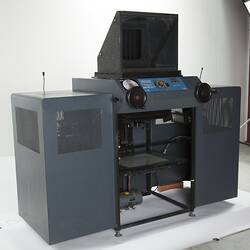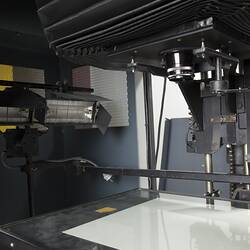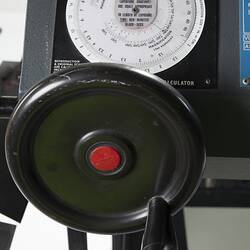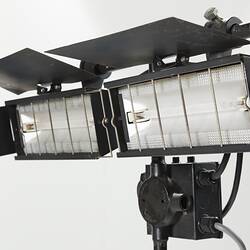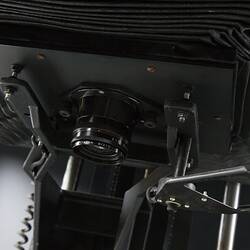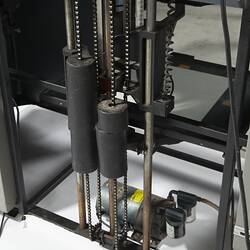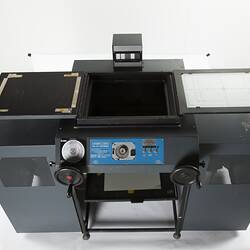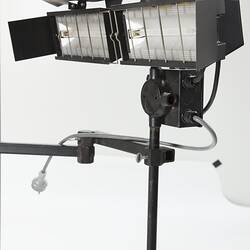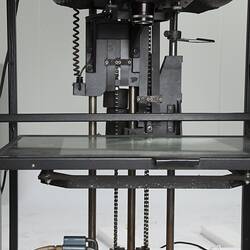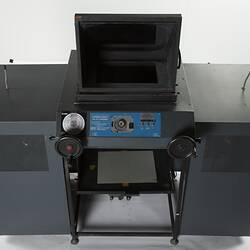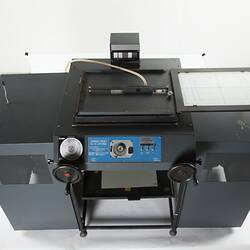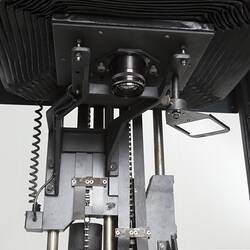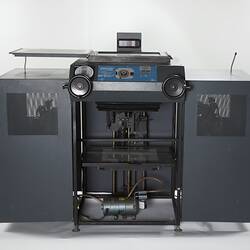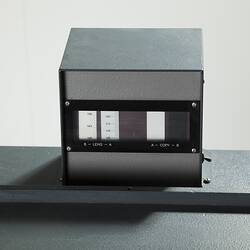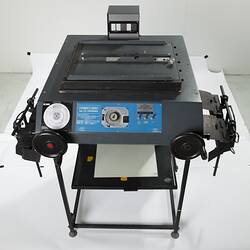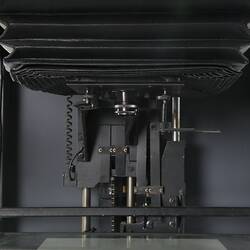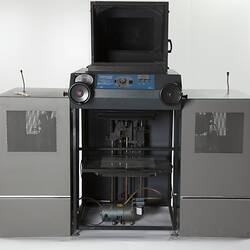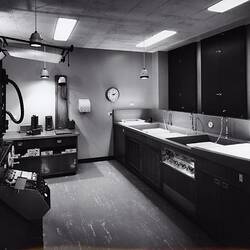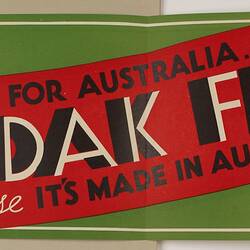Summary
Littlejohn Graphic Systems Ltd 'Copyspeed Type 170' process camera, designed to use film in a format up to 16 x 20 inches, and made in London circa 1950s. With adjustable bellows and platen, or copy board, the user could make enlargements or reductions from either negative or positive prints.
This camera was used in the Packaging Design department of Kodak Australasia Pty Ltd at the Coburg factory from about the 1950s until the early 1980s. It would have been used to produce design material for much of the Australian designed and made packaging from the mid twentieth century that is now held in the Kodak Heritage Collection at Museum Victoria.
In the early 1980s, when the camera became surplus to requirements in the Packaging Design department, it was then acquired by the donor, who was an employee in the Engineering Department at Kodak from 1979 to 1990. He and his Engineering Department colleagues used the camera for about 10 years, for the production of electronic printed circuit boards used in machine control systems that were involved in the manufacture of Kodak photographic films and paper.The circuit boards would be designed using special tape and stickers on a clear film, twice actual size. This was then photographed with the camera and reduced to actual size. The resulting negative would then be used to expose pre-sensitized copper film-coated circuit board material. After developing the exposed board, it would be etched in a solution that dissolved away the unexposed copper, leaving the required circuit board copper tracks.
The donor, an electrical engineer, later purchased the camera for private use, when it became surplus to the Engineering Department at Kodak, and used it at home to produce negatives for electronic circuit boards and screen printing. He designed and made specialised battery chargers, mainly for use with underwater lighting systems used in cave diving, and the camera was very useful for making the circuit boards in these devices. The screen printing he did was mainly for the printing of t-shirts for various clubs and associations, but also to print curtain materials and even the donor's wedding invitations, using custom artwork by a local artist.
The camera is complete and still in working order.
This camera is similar to the camera featured in a Kodak Heritage Collection photograph, MM 98981, which shows the Graphic Arts darkroom at the Kodak Technical Service Centre at the Kodak factory complex in Coburg, 1964.
Littlejohn Graphic Systems was a London company incorporated in 1927, which manufactured process cameras of many sizes, this probably being one of the smaller ones. It later became SR Littlejohn, and in the early 1960s Hunter Penrose purchased S R Littlejohn, to become Hunter Penrose Littlejohn. The company has had many changes since then and is now known as Hunter Penrose.
Physical Description
Process camera to fit maximum film size 16x20". It includes a Schneider Kreuznach G-Claron 210mm lens in extendable leather bellows, vacuum film board, 4 x 750 watt tungsten lamps mounted in two light brackets, painted black, a horizontal light support bracket, a platen and platen carrier, 2 x bellows counterweights, 1 x platen counterweight, 2 x roller chains, left and right hand wheels and a removable rear cover panel. In addition to these components, there are several parts currently stored separately. These are: a removable 45 degree viewing hood to allow vertical focusing and film loading,a vacuum pump, a ground glass viewing pane and 2 x light covers with ventilation grids. On the control panel of the main camera unit is a magnification and exposure wheel, a blue manufacturer's plate with a dial, exposure adjustment, and three switches with graphic indicators. From left to right the switches operate the lights, vacuum, and exposure. There is a raised panel with two scales connected to the bellows and platen.The entire main unit is painted metallic blue-grey with black wooden edging around the bellows, mounted on a steel frame.
More Information
-
Collection Names
-
Collecting Areas
-
Acquisition Information
Donation from Lothar Ploss, 14 Jun 2012
-
Manufacturer
Littlejohn Graphic Systems Limited, England, Great Britain, circa 1950s
-
Place & Date Used
Packaging Design, Kodak (Australasia) Pty Ltd, 173 - 199 Elizabeth Street, Coburg, Greater Melbourne, Victoria, Australia, circa 1950-1981
It is not clear when the camera began use at Kodak but it was probably made in the 1950s and introduced soon after. -
Place & Date Used
Engineering Department, Kodak (Australasia) Pty Ltd, 173 - 199 Elizabeth Street, Coburg, Greater Melbourne, Victoria, Australia, 1980s
When taken out of use in the Packaging Department, it was used for printing circuit boards in the Engineering Department -
Inscriptions
Front left, engraved: 'REPRODUCTION . & ORIGINAL SCALES / ARE CALIBRATED FOR / INCHES (0.1" DIVISIONS) / OR CMS (MM DIVISIONS) / MAGNIFICATION AND EXPOSURE CALCULATOR' Front centre, engraved: 'LITTLEJOHN / 20 X 16 / TYPE 170 COPYSPEED / MANUFACTURE BY / LITTLEJOHN GRAPHIC SYSTEMS LTD. / 16-24 BREWERY ROAD / LONDON N7 / VOLTS 240 PH 1 ~ 50 / AMPS 15 MACH N2 / 21802' Front, right, sticker, printed, black ink: 'SUPPLIED BY / CARMICHAEL'S / GRAPHIC ARTS MACHINERY / SYDNEY - MELBOURNE - BRISBANE / ADELAIDE - PERTH / AUCKLAND - WELLINGTON N.Z.' / (in relief) 'CARMICHAEL AND COMPANY / A DIVISION OF DALTON INDUSTRIES PTY. LIMITED'
-
Classification
-
Category
-
Discipline
-
Type of item
-
Overall Dimensions
1930 (Width), 910 (Depth), 1430 (Height)
Overall physical size with light covers - 1930W x 910D (not including adjusting wheels) x 1430H (not including 45deg unit, but including scale housing) Overall physical size of main unit without light covers 800W x 910D (not including adjusting wheels) x 1430H (not including 45deg unit, but including gla
-
References
[Link 1] accessed 28 Feb 2013.
-
Keywords
Photography, Cameras, Manufacturing Processes, Circuit Boards, Packaging, Working Life, Making History - Kodak Collection

